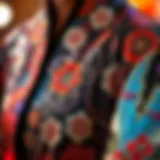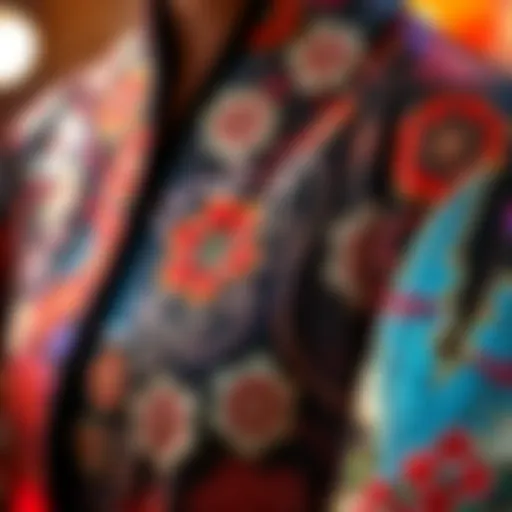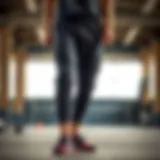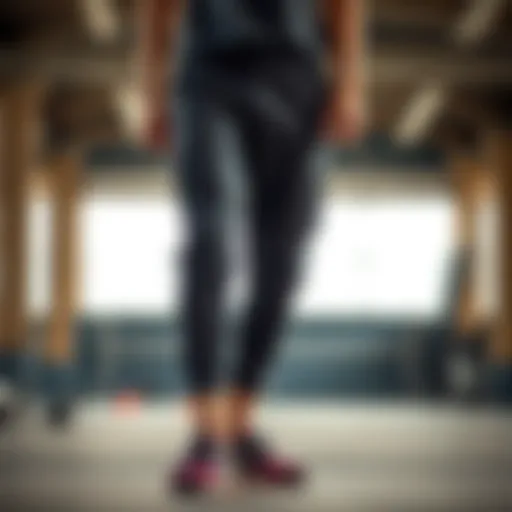The Hot Suit Jacket: History, Trends, and Style Guide


Intro
The hot suit jacket has evolved from a versatile garment into a statement piece of modern fashion. Originating from formal attire, this jacket now straddles the line between professional and casual, adapting seamlessly to various contexts. Understanding its significance requires a deep dive into its historical roots, the materials that breathe life into its structure, and the tailoring techniques that define its fit.
As this exploration unfolds, we'll touch on the essential fabric knowledge, offer style tips, and dissect how this garment can be an expression of personal style and professional acumen. The purpose of this article is not only to celebrate the hot suit jacket's journey through time but also to provide valuable insights for fashion enthusiasts, stylists, and retailers alike.
Fabric Knowledge
Types of Fabrics
When it comes to the hot suit jacket, the choice of fabric plays a pivotal role in its overall impact. Understanding the different fabrics available can enhance the functionality and aesthetic of the jacket. Here are some of the most popular types:
- Wool: A classic choice, wool fabric is known for its durability and warmth. It can vary from light to heavy weights, making it suitable for different seasons.
- Cotton: Often chosen for its breathability, cotton is ideal for less formal occasions. It provides comfort while maintaining a polished look.
- Linen: Perfect for those warm summer days, linen has a relaxed texture and great moisture-wicking properties. However, it wrinkles easily, so care must be taken.
- Silk: This luxurious fabric adds a touch of elegance and is typically chosen for special occasions. It can be blended with other fabrics to improve durability.
By knowing the characteristics of these fabrics, one can make informed decisions when selecting the right hot suit jacket for a given situation.
How to Care for Different Fabrics
Every fabric has its own quirks when it comes to maintenance. Here are essential tips for caring for suits made from various materials:
- Wool: Regular brushing can help rid the fabric of dust and lint. For stains, use a damp cloth immediately. Professional dry cleaning is advisable once a season.
- Cotton: This fabric is more forgiving—machine wash on gentle cycles and tumble dry low. Ironing may be necessary, so keep a spray bottle handy to combat wrinkles.
- Linen: Always dry clean if possible, but if washing, do so gently. Expect wrinkles; embrace the casual look that linen provides instead of stressing over every crease.
- Silk: This one’s tricky. Always dry clean silk jackets to maintain their luster, but if you must wash, hand wash in cold water and avoid wringing them out.
Foreword to the Hot Suit Jacket
In the realm of fashion, the hot suit jacket stands as a paragon of elegance, versatility, and style. Its journey from traditional formal wear to contemporary fashion staple warrants a closer look, as it reflects not only personal taste but also cultural influences that shape our attire choices. Understanding the significance of the hot suit jacket requires a deep dive into its definition, evolution, and the context in which it thrives.
Definition and Overview
A hot suit jacket, often a tailored piece made from quality fabric, embodies the intersection of comfort and sophistication. Typically characterized by a tailored fit, structured shoulders, and distinct lapels, it serves as the upper garment for both formal and casual attire. Unlike its more utilitarian counterparts, the hot suit jacket often incorporates updated features like contemporary cuts, unique stitching, and vibrant colors, catering to those who want to express their individuality without compromising on style.
When we speak of a "hot" suit jacket, it implies a garment that is not only fashionable in the seasonal sense but also one that resonates with current trends and societal moods. It’s a garment that commands attention, whether it’s the centerpiece of a boardroom meeting or the star of a social gathering. Just like a fine wine, the right jacket can mature with the wearer, becoming more refined and appealing with each use.
Cultural and Contextual Significance
The cultural relevance of the hot suit jacket is twofold: it signifies status and represents freedom of expression in today's world. Historically, suits were once the domain of the upper class, serving as a visual cue to one's position in society. This visual language has evolved; now, a hot suit jacket can be worn by anyone seeking to enhance their presence, redefining traditional boundaries.
Fashion enthusiasts often find frames and inspirations in moments of cultural significance, whether it’s the roaring twenties with their penchant for jazz and eccentric styles or the sleek silhouettes of the modern day influenced by social media trends. The suit jacket adapts, melding into the fabric of societal changes, acting as a mirror reflecting current aesthetics and values.
Moreover, its contexts vary; from high-powered business meetings in Manhattan to laid-back brunches in Los Angeles, the hot suit jacket fits seamlessly into diverse scenarios. This adaptability speaks volumes about its importance; it is more than just a piece of clothing—it is an extension of one’s identity and a means to make a statement.
In summary, the hot suit jacket is much more than a garment; it is a cultural artifact, a symbol of evolution, and an essential item for anyone wanting to make a polished impression in any setting. Delving deeper into its historical roots and fabric details will further enhance our understanding of its significance in today’s fashionable landscape.
Historical Perspective on Suit Jackets
Understanding the historical perspective of suit jackets is paramount in grasping their significance today. The evolution of this garment reflects societal shifts, changes in fashion sensibilities, and economic factors that have influenced style over the years. Tracing its origins and transformation allows both fashion enthusiasts and professionals to appreciate the nuances of contemporary designs and the cultural undercurrents they represent. Through examining the lineage of the suit jacket, readers can glean insights into how identity, power, and fashion intersect.
Origin of the Suit Jacket
The suit jacket, as we know it, traces its roots back to the 19th century, emerging from the frock coat. Initially, the frock coat was a long, tailored garment worn primarily by men in connection to the evolving landscape of fashion in Europe. The basic premise of the suit jacket was to provide a more practical alternative, favoring functionality without sacrificing elegance. Tailors began crafting jackets with shorter lengths and fitted silhouettes, making it easier for the wearer to carry on with their daily activities.
It was during the Victorian era that the concept of formal clothing took a sharper turn. The industrial revolution paved the way for mass production, but also revitalized custom tailoring. At this time, men began to adopt a more standardized attire that included vests, trousers, and a tailored jacket. As men's fashion evolved, the simple but stylish look of the suit jacket gained favor among the elite and working classes alike.
Evolution Through the Decades
As decades rolled on, the suit jacket underwent various transformations, mirroring the shifting tides of fashion trends.


- 1920s - 1940s: This era witnessed the jazz age and the roaring twenties, where the suit jacket became a symbol of consented authority in a post-war society. The 'sack suit' became popular—characterized by its loose fit and relaxed lines, which spoke to the playful yet sophisticated manners of the time. This loose style continued into the Great Depression and World War II, where utility became more important than style.
- 1950s - 1960s: Post-war prosperity led to a resurgence of luxury. The tailored suit jacket returned, now slightly narrower with sharper lapels. Icons like Cary Grant and James Dean embodied the style of this time. It became less a statement of power, more a reflection of personal style.
- 1970s - 1980s: Bold patterns and colors dominated the scene in the 70s, moving away from traditional styles. The double-breasted jacket made a comeback in the early '80s, paralleling the corporate boom. This era set the stage for the modern power suit.
- 1990s - Present: The 90s introduced a more casual aesthetic, with an emphasis on comfort; suit jackets became available in softer fabrics and styles. By the 2000s, designers embraced innovation, mixing traditional cuts with contemporary elements, allowing for diverse interpretations of the suit jacket today.
In summary, the suit jacket's journey from an essential piece of wardrobe for Victorian gentlemen to a staple reflecting personal identity today symbolizes more than just fashion—it's a narrative of societal evolution and cultural shifts. With the passage of time, the jacket's material, fit, and aesthetic have transformed, shaping and reshaping its status to remain relevant in today's clothing palette.
Fabric Characteristics That Define a Hot Suit Jacket
The fabric of a hot suit jacket isn't just a matter of preference; it's a decisive factor that influences comfort, durability, and overall style. Understanding the characteristics of the materials used in suit jackets is essential for anyone looking to invest in a timeless piece. An ideal jacket not only complements a wearer’s physique but also adapts to various situations and seasons, making fabric choice crucial. Here we dissect three common fabrics that define hot suit jackets, focusing on their unique attributes, advantages, and considerations.
Wool: Timeless Quality and Durability
Wool has held its ground as a favorite fabric for suit jackets. Renowned for its excellent insulation, it keeps the body warm in colder temperatures while remaining breathable in warmer weather. Simply put, this fabric does miraculous things when it comes to temperature regulation, allowing the wearers to feel comfortable no matter the climate.
- Quality: The quality of wool is dictated by its fineness and length of the fibers. Merino wool is a prime example, offering a soft texture yet robust performance. Higher-end suits often utilize Super 100s to Super 150s wool, known for their refined texture and luster.
- Durability: Wool's natural elasticity means it can withstand bending and stretching without losing its structure. Hence, a properly maintained wool suit can last for years, making it a wise investment.
- Care Tip: Ensure proper cleaning through dry cleaning to maintain its shape and finish, as washing may cause shrinkage.
"A suit jacket is a worthy investment if it withstands the test of time, much like a good bottle of wine - it only gets better as it ages."
Linen: The Breathable Option for Warm Weather
When it comes to hot climates, linen jumps to the forefront, making it a desirable option for those sweltering summer days. Its lightweight nature and ability to wick moisture away from the body make it ideal for maintaining coolness.
- Breathability: Linen's open weave contributes to its superior breathability, allowing air to circulate effectively. This is especially advantageous in humid weather, where sweat tends to cling.
- Texture: Linen is known for its slightly coarse feel, often regarded as part of its charm. The fabric's unique texture lends a relaxed vibe, making it perfect for casual yet elegant occasions.
- Care Tip: Linen tends to wrinkle easily; thus, be prepared for a slightly crumpled appearance, which many enthusiasts find adds to its character.
Cotton: Versatility and Comfortable Fit
Cotton, a staple fabric across wardrobes, brings versatility to suit jackets. The fabric's affordability and comfort level make it a popular choice.
- Softness: Known for its softness, cotton provides comfort like no other. The fabric has a smooth finish that feels gentle against the skin, making it a strong contender for daily wear.
- Adaptability: Cotton can be blended with other materials, like polyester or linen, to enhance performance while retaining its inherent softness. This versatility means that cotton suits can range from ultra-formal to relaxed casual, making it suitable for diverse occasions.
- Care Tip: Cotton can be machine washed, but be mindful of the heat settings during drying to prevent shrinkage.
Understanding these fabric characteristics elevates one's ability to select the right hot suit jacket for individual needs and contexts. Investing time in learning about fabric options leads not only to a better fit but also to informed choices that enhance one's wardrobe.
Tailoring Techniques for the Perfect Fit
When it comes to achieving that polished look with a hot suit jacket, tailoring plays a foundational role. Tailoring techniques can make or break the overall impression of your outfit. A perfectly tailored jacket complements the wearer's physique, enhances confidence, and ultimately serves as an emblem of professionalism and flair. No one wants to look like they’re swimming in their suit, or worse, like it’s been squeezed onto them like a sausage.
A well-tailored jacket adjusts in all the right places—shoulders, waist, and sleeve lengths—ensuring your ensemble looks sharp and intentional. Let's delve deeper into the essential aspects of tailoring that every fashion enthusiast should consider.
Understanding Tailoring Basics
At its core, tailoring involves adjusting the structure of a suit jacket to fit an individual's body contours. Here are some basic tailoring terminologies and techniques:
- Fit Types: Understanding whether you need a slim, regular, or relaxed fit is crucial. Each caters to different body shapes and personal styles.
- Measurements: Accurate measurements are the lifeblood of effective tailoring. This includes shoulder width, chest circumference, and sleeve length, among others.
- Adjustments: Common modifications include:
- Taking in the sides for a slimmer silhouette.
- Shortening or lengthening sleeves for proportion.
- Altering lapel sizes to match personal style preferences.
In practice, it’s wise to consult with a professional tailor who can assess your unique body shape and make recommendations tailored for you. It’s not just about looking good; it’s about feeling great in your skin.
Bespoke vs. Off-the-Rack: What's The Difference?
When discussing tailoring, two main styles often arise—bespoke and off-the-rack. Each has its pros and cons, so let’s unpack these:
- Bespoke:
- Off-the-Rack:
- Custom-Fit: Every piece is crafted to your exact measurements and style preferences, ensuring an unparalleled fit that feels tailored just for you.
- Quality of Craftsmanship: Typically made from higher-quality fabrics and finished with meticulous workmanship, bespoke jackets often last longer and hold their shape better over time.
- Cost Factor: The price tag is usually higher, reflecting the labor-intensive process and premium materials used.
- Accessibility: Readily available in stores or online, off-the-rack suits offer convenience but may not accommodate every body type perfectly.
- Affordability: Generally more budget-friendly, allowing consumers to pick stylish options without breaking the bank.
- Limited Customization: While some stores offer alterations, these adjustments may not resolve all fitting issues, leading to compromises in comfort and appearance.


In the end, choosing between bespoke and off-the-rack comes down to priorities—be it affordability, convenience, or the pursuit of a perfect fit. Ultimately, investing time and thought into the fit of your hot suit jacket can elevate not just your appearance, but the very way you carry yourself.
The Role of Color and Pattern in Suit Jackets
The color and pattern of a suit jacket can make or break an outfit. They serve not just as aesthetic choices, but they also communicate subtle messages about the wearer’s personality, mood, and the occasion itself. In a world where first impressions count, understanding the significance of these elements can give anyone an edge in both professional and social environments. The hot suit jacket, often regarded as both a staple and a statement piece in one’s wardrobe, benefits greatly from thoughtful choices in color and pattern.
Choosing the right colors and patterns is more than just coordinating hues. It’s about creating a dialogue between the wearer and their environment, signaling confidence, authority, or creativity. More than a flair for fashion, this element of a suit jacket often carries cultural implications and communicates alignment with contemporary trends.
Classic Colors: Black, Navy, and Gray
When it comes to classic colors, black, navy, and gray stand the test of time for a reason. Each of these colors has stood the test of time, lending an air of sophistication and professionalism that few others can match.
- Black: The quintessential color for formal wear, black suits are often associated with power and formality. They are prominently featured in business-world settings and formal events. Choosing black offers versatility. Pair it with a crisp white shirt for a timeless look. Alternatively, a brighter tie can introduce a splash of contrast.
- Navy: This color strikes a balance between professionalism and approachability. Navy suits work well in almost any setting, from interviews to weddings. They carry a certain warmth, allowing for combinations with lighter shirts or bright accessories, which can tell a story of confidence without losing approachability.
- Gray: Often seen as the underdog of classic colors, gray showcases a spectrum from light to charcoal. It is highly adaptable, offering a modern touch while still maintaining sophistication. Grey can neutralize strong patterns, allowing for an adventurous tie or pocket square to take the spotlight.
Colors more than just fabric swatches—they interact dynamically with personal style. Each hue's psychology goes deeper than mere visual appeal, resonating with the observer on a psychological level.
"Wearing a classic color doesn’t just align with trends; it’s about signaling your understanding of the setting you're in, be it in a meeting room or a banquet hall."
Bold Patterns: A Statement of Individuality
While classic colors provide a foundation for elegance, patterns bring an entirely different edge to the hot suit jacket. Bold patterns like checks, plaids, and stripes can serve as a canvas for personal expression. Such choices might seem daring, but they can communicate individuality and confidence in remarkable ways.
- Checks: A checked suit can convey both authority and creativity. For instance, a subtle check can enhance a business look while allowing the wearer’s personality to shine through. More vibrant designs can take on a more relaxed tone, making them suitable for evening gatherings.
- Plaids: This bold pattern often straddles the line between traditional and modern. Depending on the colors used, a plaid suit can evoke a rustic charm or a contemporary vibe. Pairing it with solid-color accessories helps maintain balance, allowing the pattern to be the focal point.
- Stripes: Vertical stripes can be particularly effective in conveying a long, lean silhouette. They are often used in business suits to suggest professionalism. However, thicker and more colorful stripes can easily shift into casual territory, giving the suit versatility and flair.
Incorporating bold patterns into a suit jacket is truly an adventurous choice. While classic colors invoke familiarity, patterns invite curiosity, making the wearer intriguing and memorable.
With these elements in play, it's clear that the role of color and pattern in suit jackets is far from superficial. Rather, they anchor style choices, allowing personal expression while maintaining a semblance of decorum. Each choice is a layer in the narrative one's suit jacket tells.
Styling the Hot Suit Jacket
When it comes to the hot suit jacket, styling goes beyond mere aesthetics. It transforms a simple piece of clothing into an expression of personality, status, and occasion. The right style can elevate someone's appearance in a boardroom, and at a wedding, or even during a casual meetup. As we dive into the specifics of styling a hot suit jacket, several elements demand attention.
First and foremost, it’s vital to recognize that a suit jacket is more than just an overlay; it's about creating a coherent look. Finding the right pairing with trousers or choosing the right accessories can make or break the entire outfit. Thus, styling should always be approached with an eye for detail and a thoughtful mindset toward overall appearance.
Pairing with Trousers: A Cohesive Look
The art of pairing trousers with a suit jacket is nuanced and important. One could say it’s where the magic happens, linking the top and bottom into a complete ensemble. The essence here lies in color coordination, fabric matching, and understanding the formality of the occasion.
- Color Matching: A classic choice is to match your suit jacket with trousers of the same color. A navy jacket with navy trousers provides a sleek, uniform look. However, introducing a contrasting color can also be striking. Think about pairing charcoal with lighter gray trousers for that perfect balance.
- Fabric Consideration: Not all fabrics play well together. Mixing a heavy wool jacket with lightweight cotton trousers can create an unattractive silhouette. Instead, consider tweed trousers for a wool jacket or linen for a hot summer day’s charm.
- Fit and Tailoring: Ensure both the trousers and jacket are well-fitted. Baggy trousers paired with a tailored jacket create discord rather than harmony.
As you style your ensemble, consider these tips to achieve a well-put-together image that speaks to your fashion sense.
Accessorizing: The Details Matter
It's often said that details make the outfit, and the hot suit jacket is no exception. Accessories have the power to take an outfit from bland to extraordinary, crafting an image that resonates with confidence.
- Ties and Bowties: These pieces are the cherry on top. For a traditional look, a tie in a solid color or subtle pattern can blend beautifully. On the other hand, a bold bowtie can serve as a statement piece, reflecting personality.
- Pocket Squares: The addition of a pocket square might seem small, but it plays a big role in defining the ensemble. Choose a color that either complements or contrasts your jacket, offering a delightful pop.
- Footwear Choices: Shoes are your foundation - quite literally. A pair of polished Oxfords can enhance a formal look, while loafers can provide that laid-back vibe. Ensure the shoe color aligns with the overall aesthetic to maintain a seamless appearance.
"The right accessories turn an ensemble from just clothing into a statement about who you are."
- Watches and Jewelry: Here’s where personal style shines through. A classic watch can add sophistication, while rings or cufflinks might add a bit of flair - just be mindful of balance.
In summary, when styling a hot suit jacket, focus on the interplay between trousers and accessories. Through careful consideration, the wearer can elevate their appearance, making it both cohesive and striking. The key is to align choices with personal flair while acknowledging the context, all of which will contribute to a polished look.
Occasions for Wearing a Hot Suit Jacket


The hot suit jacket isn't just a piece of clothing; it's an emblem, a statement that communicates not only style but also intent. Various occasions demand different levels of formality, and knowing when and how to wear a suit jacket is vital. Let's delve into these significant occasions, illuminating distinct scenarios where the hot suit jacket can play a crucial role.
Professional Settings: Making an Impression
In the realm of professional settings, first impressions can be akin to turning the key of opportunity. Wearing a well-fitted hot suit jacket can elevate your presence during meetings, interviews, and corporate events. The key is to choose a jacket that harmonizes with the nature of your job and the corporate culture you're part of.
A tailored charcoal or navy jacket can speak volumes at a job interview, showcasing that you mean business. It isn’t merely about wearing a suit; it’s about embodying professionalism. Remember, details count. Opt for a jacket that allows freedom of movement, especially if you are expected to engage actively. This not only enhances comfort but assures your body language reflects confidence.
"Dressing well is a form of good manners." - Tom Ford
Formal Events: Dressing to Impress
Formal occasions, like weddings, gala dinners, and upscale gatherings, call for an extraordinary level of sophistication. The hot suit jacket shines in these scenarios, offering versatility while ensuring you remain the center of attention.
When attending a formal event, consider the venue and the theme. For a winter wedding, a deep burgundy jacket paired with classic black trousers could be a show-stopper. Meanwhile, in summer affairs, lighter shades, such as beige or pastel colors, help maintain a dapper appearance without compromising comfort. Accessories like pocket squares, cufflinks, and a well-chosen tie can enhance your overall ensemble, turning heads and sparking conversations.
Casual Gatherings: The Versatile Option
The beauty of the hot suit jacket is its ability to adapt to casual settings without losing its charm. Gatherings at friends' homes, casual dinner dates, or informal networking events welcome this versatile piece, granting you the freedom to express your individuality while still appearing polished.
For instance, a lightweight cotton suit jacket in a relaxed fit can match perfectly with jeans or chinos. Roll up the sleeves a little, and you capture just the right mix of laid-back elegance. Comfort is key; thus, selecting fabrics that breathe while allowing ease of movement is essential. Experiment with color and patterns in less formal contexts to truly showcase your personal style while still relying on the hot suit jacket as a cornerstone of your outfit.
In summary, understanding the occasions for wearing a hot suit jacket and choosing the right one can make a world of difference in how you're perceived. It's all about context, confidence, and above all, the courage to express your unique identity.
Maintaining and Caring for Your Suit Jacket
Caring for your suit jacket is akin to nurturing a fine wine; it requires patience, knowledge, and attentiveness to ensure it retains its allure and integrity over time. The hot suit jacket, with its blend of style and functionality, deserves a thoughtful approach to maintenance, ensuring it remains a staple in your wardrobe for many occasions to come. Regular care not only prolongs the life of the garment but also maintains its shape, color, and fabric quality, allowing you to shine in any professional or formal setting.
Cleaning Techniques: Dry Clean or Wash?
When it comes to keeping your suit jacket spick and span, the question of cleaning methods often crops up. Should you opt for dry cleaning or a more basic washing approach? Here’s a breakdown:
- Dry Cleaning: Generally recommended for wool and blended fabrics, dry cleaning uses solvents to lift stains without water, preserving the fabric's structure. It’s the safest bet for deeper cleaning as it minimizes shrinking and color fading.
- Hand Washing: For those who are more adventurous, hand washing using cold water is a viable option for cotton or linen suit jackets. It’s crucial to gently scrub specific areas and avoid wringing out the fabric to prevent damage.
- Spot Cleaning Techniques: Having a handy fabric brush and lint roller is smart for minor stains or surface debris. A little water and a mild detergent can help with spot cleaning without the need for a full wash.
While there are certain benefits to each method, frequent visits to the dry cleaner can be harsh on your wallet and the environment, so striking a balance is key. Use dry cleaning sparingly and rely on hand washing or spot cleaning for regular upkeep.
Storage Tips for Longevity
Storing your suit jacket correctly is just as important as cleaning. Proper storage ensures your jacket maintains its shape and prevents unwanted creases or damage. Here are essential tips to keep in mind:
- Use a Good Quality Hanger: Invest in wooden or high-quality padded hangers. They maintain the jacket's shape better than wire or flimsy plastic hangers, preventing unsightly shoulder bumps.
- Avoid Plastic Garment Bags: While it may seem logical to protect your jacket in plastic, these can trap moisture and create mold. Instead, opt for breathable cotton dust bags.
- Keep Away from Light: UV rays can fade colors, so hang your jacket in a dark or shaded space.
- Air it Out: After wearing it, let the jacket air out for a while before putting it back in storage, preventing odors from settling.
"Caring for your suit jacket is not just an act of maintenance but a testament to your appreciation of style."
Consider storing the jacket in a climate-controlled environment, as extreme temperatures can warp its fibers. Taking the time to ensure the right conditions can save you money in the long run by avoiding early replacements.
With the right mindset towards cleaning and caring for your hot suit jacket, you can enjoy its versatility in style while being confident in its enduring presence in your wardrobe.
The End: The Enduring Appeal of the Hot Suit Jacket
The hot suit jacket always holds a special place in the world of fashion. It’s not just a piece of clothing; it's a powerful statement that can reflect personality and status. Over time, its evolution mirrors societal changes and individual transformations. Each era’s take on the hot suit jacket tells a story of its own, showcasing the balance between style and utility, and this duality remains at the heart of its lasting appeal.
Final Thoughts on Style and Utility
When thinking about the hot suit jacket, we have to acknowledge its versatility. This is a garment that fits various occasions through clever styling and innovative fabric choices. Whether you’re dressing up for a formal event or making the rounds in a casual gathering, the right jacket can elevate the entire outfit. Its ability to adapt to personal style and fashion trends is a testament to its significance in modern wardrobes.
- Timelessness: The jacket endures because it’s always in circulation. From vintage shops to modern boutiques, they're present across decades, keeping their charm alive.
- Personal Expression: The way one styles a hot suit jacket speaks volumes. Layering, textures, and colors can personalize any look, allowing individuals to showcase their unique flair.
- Quality and Craftsmanship: Investing in a well-tailored hoc suit jacket pays off in the long run. Quality fabrics and precise fittings contribute not just to appearance, but also to comfort and durability.
The hot suit jacket remains more than a fashion choice; it’s a blend of tradition and modernity. In every stitch, there lies a rich history, and in every fit, personal stories unfold. As society continues to evolve, so too will the hot suit jacket—adapting while retaining its core identity. In this way, it encapsulates an everlasting elegance that both fashion enthusiasts and everyday wearers appreciate.
"A well-fitted suit can be the difference between blending in and standing out."
In essence, the hot suit jacket is a canvas for creativity while ensuring a level of sophistication that speaks to both the present and future of fashion. Its enduring appeal lies in this delicate balance, making it a staple for anyone seeking to make a statement.















